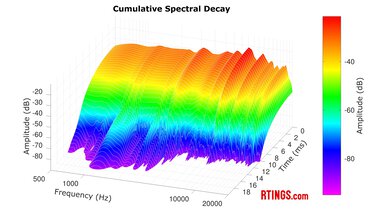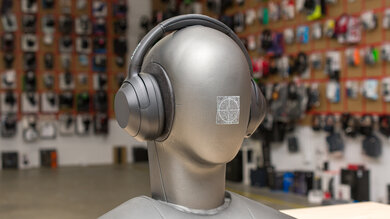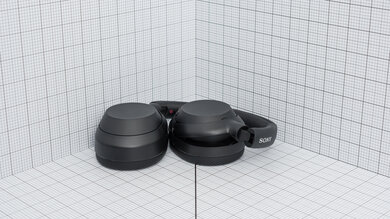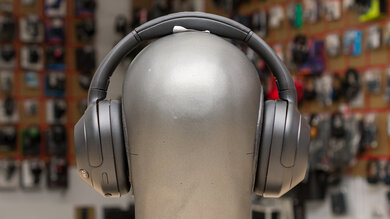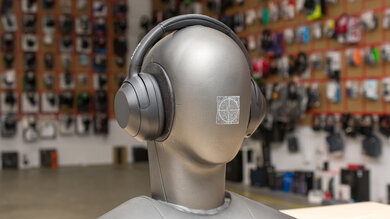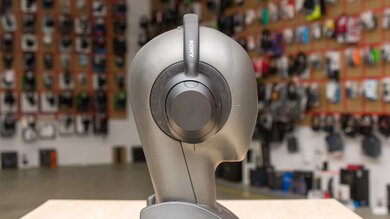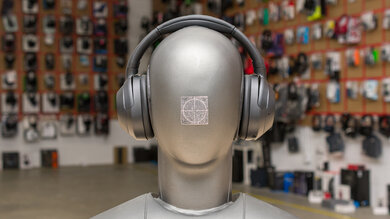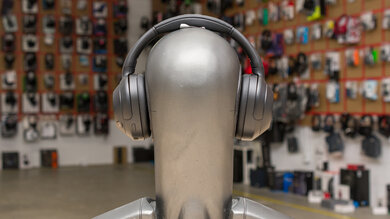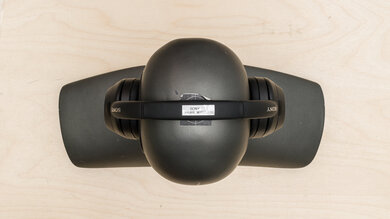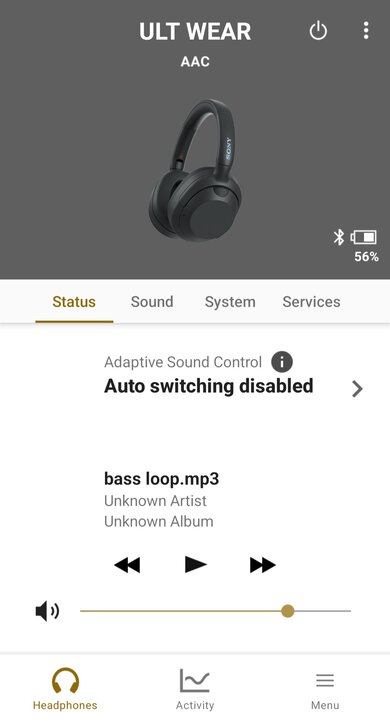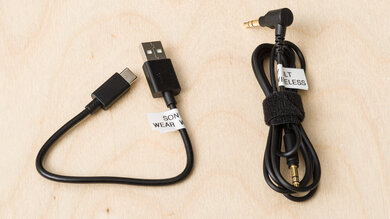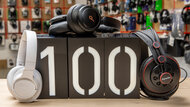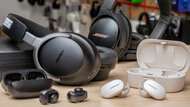The Sony ULT WEAR are mid-range over-ears equipped with active noise cancelling (ANC). They're positioned between the more affordable Sony WH-CH720N Wireless and the flagship Sony WH-1000XM5 Wireless. As they previously did with the 'XB' lineup, Sony are aiming these headphones at users who prefer a bass-heavy sound. The 'ULT' in their name corresponds to the 'ULT' bass button, which can introduce two additional levels of low-frequency enhancement. With an advertised 40 hours of continuous battery life, these over-ears have what it takes to get you through multiple work days or long trips without needing to recharge.
Our Verdict
The Sony ULT WEAR headphones are decent for sports and fitness use. While they're not the most portable headphones, they're comfortable, well-built, and surprisingly stable, considering their bulky fit. Their controls are intuitive and easy to use once you get the hang of them, so it's simple enough to adjust basic parameters on the fly. Their 44-hour battery life is also long enough that you don't need to worry about running out of juice at all, bar the most grueling ULT(ra) marathons.
-
Comfortable, stable fit.
-
Default sound profile can weaken intelligibility of voices in busy mixes.
The Sony ULT WEAR are very good for commuting and traveling. While they're not the most portable headphones, they come with a solid carrying case to help with transport. They're comfortable and well-built, too, with a 44-hour battery life that'll get you through multiple long journeys with layovers to boot. Their ANC performance is excellent and does a great job of blocking out external noise across the entire frequency range, whether it's airplane engine rumble or wailing infants. You'll want to be a little careful when it comes to blasting your tunes in quiet environments, though, as leakage will be audible to those in your immediate proximity.
-
Comfortable, stable fit.
-
44 hours of battery life with ANC on.
-
Mic has decent recording quality and great noise handling.
-
Amazing noise isolation thanks to ANC.
-
Can't use LDAC and Bluetooth multipoint simultaneously.
-
Default sound profile can weaken intelligibility of voices in busy mixes.
The Sony ULT WEAR headphones are very good for office use. They're comfortable, stable, and well-built, and their 44 hours of continuous battery life can effectively last you an entire workweek without needing to recharge. While they're not the most portable, this won't be an issue if you plan on leaving them at your desk. Their ANC system does an amazing job of blocking out the sound of scraping chairs and chatty coworkers, and the integrated mic has great noise handling and decent recording quality, making these a solid pair of headphones for calls and meetings.
-
Comfortable, stable fit.
-
44 hours of battery life with ANC on.
-
Mic has decent recording quality and great noise handling.
-
Amazing noise isolation thanks to ANC.
-
Can't use LDAC and Bluetooth multipoint simultaneously.
-
Default sound profile can weaken intelligibility of voices in busy mixes.
The Sony ULT WEAR aren't suitable for wireless gaming as latency is too high when using a wireless connection.
The Sony ULT WEAR are good for gaming when connected via their 1/8" TRS audio cable. Latency is very low when using this connection type, though you'll want an external microphone if you like to chat while you game as the mic isn't active if you use the headphones passively. The boomy bass response is great for bringing life to explosions and action-packed sequences, but the uneven treble response can add some harshness to higher-pitched cinematic sound effects while veiling S and T sounds in dialogue and making voices harder to make out. Their closed-back design isn't the biggest aid in locating objects, like footsteps, in the stereo field either. They're comfortable and stable enough to stay on your head through even the most jump-scare-filled cutscenes.
-
Comfortable, stable fit.
-
Low latency when connected via analog cable.
-
Default sound profile can weaken intelligibility of voices in busy mixes.
The Sony ULT WEAR have decent audio reproduction accuracy, but that's to be expected. You don't buy these headphones because you want a detailed, analytical reference sound. You buy them because you love bass and want as much as you can get. And to that end, they work very well. A few inconsistencies in the low-treble phase and frequency response mean objects like voices can feel slightly one-sided, but their amazingly good distortion performance means you can turn these up loud without adding artifacts to your audio. Bass lovers rejoice.
The Sony ULT WEAR have excellent noise isolation performance. They effectively block out everything from the low rumbles of plane engines to the traffic noise and the chatter of nearby coworkers.
The Sony ULT WEAR have a good microphone, with great noise handling. While your voice lacks a little warmth and sparkle, the mic system does a good job separating it from any noise around you.
The Sony ULT WEAR have very good frequency response consistency. Between seatings and for most physical characteristics, your perception of the headphones' sound will closely match the measured frequency response. That said, if you wear glasses, you may experience minor inconsistencies in bass delivery.
- 7.4 Sports And Fitness
- 7.9 Travel
- 7.9 Office Work
- 5.9 Wireless Gaming (In Development)
- 7.5 Wired Gaming (In Development)
Performance Usages
- 7.3 Audio Reproduction Accuracy
- 8.6 Noise Isolation
- 7.7 Microphone (In Development)
- 7.8 Frequency Response Consistency
Changelog
-
Updated Apr 25, 2025:
This review has been updated to Test Bench 2.0, which adds the following tests: Stereo Mismatch, Group Delay, Cumulative Spectral Decay, PRTF, Harmonic Distortion, and Electrical Aspects. We've added new performance usages and updated the text throughout the Sound tests and side-by-sides.
- Updated Apr 25, 2025: We've converted this review to Test Bench 2.0, which updates our sound tests and adds performance usages. You can read more about this in our changelog.
-
Updated Dec 05, 2024:
Several Sound tests have been updated following TB 1.8. There have also been text changes made throughout the review, including to the usages and product comparisons to match these results.
- Updated Dec 02, 2024: We've converted this review to Test Bench 1.8, which updates our target curve and Sound tests. You can read more about this in our changelog.
- Updated Jul 24, 2024: We've added a comparison between these headphones and the Fairphone Fairbuds XL Wireless in Build Quality.
Check Price
Differences Between Sizes And Variants
The Sony ULT WEAR are available in three different color variants: 'Off White,' 'Forest Gray,' and 'Black.' We tested the 'Black' variant, but we expect other color variants to perform similarly. You can see our unit's label here. If you encounter another variant, please let us know in the comments, and we'll update our review.
Popular Headphones Comparisons
The Sony ULT WEAR are mid-range wireless over-ears. They have an even more bass-heavy sound profile, than the manufacturer's flagship premium over-ears, the Sony WH-1000XM5 Wireless, with the ULT WEAR also having a de-emphasized treble response by comparison. While their ANC is excellent and does a solid job of isolating you against noises across the entire frequency range, it's not quite as adept at attenuating low-frequency sounds as the XM5. Otherwise, there's not too much to split these two over-ears besides plastic quality and quality-of-life features. While previous Sony headphones have been marketed on the basis of having extra bass, like the Sony WH-XB910N Wireless, this is the first pair of Sony over-ears to feature a dedicated button to cycle through levels of bass enhancement.
If you're in the market for bass-heavy headphones but your budget can't stretch to the ULT WEAR, consider the Anker Soundcore Life Q30 Wireless, which have plenty of bass on tap as well as great noise isolation. And for you on-ear aficionados, the Pioneer DJ HDJ-CUE1BT are DJ-focused headphones that supply plenty of low-end and DJ-friendly extras like swiveling earcups.
If you're looking for other headphones, see our recommendations for the best noise cancelling headphones, the best closed-back headphones, and the best travel headphones.
The Sony WH-CH720N Wireless and the Sony ULT WEAR are ANC-equipped over-ears that cater to different needs and price points. The ULT WEAR are mid-range headphones that can amp up the bass with a press of their 'ULT' button. Their higher price point comes with an improved build quality and better stability. While neither pair is an ideal pick for music production, the ULT WEAR have a boomy, bass-forward sound, while the WH-CH720N (though still bass-heavy) don't have as much low-end on tap. The ULT WEAR also feature LDAC support for high-resolution audio streaming. However, you can tailor both sound profiles to your preferences via the companion app. The main point of departure is with the ANC performance, though, as the ULT WEAR perform much better across the entire frequency range when it comes to attenuating against external noise.
Between the Sony ULT WEAR and the Bose QuietComfort Ultra Headphones Wireless, they have different pros and cons. The Sony have a much longer battery life, and despite being chunkier, they're a little more stable-fitting. Their group delay is much better, yielding tighter bass, too. For most people, though, the decision will either be determined by how much bass emphasis they want: the Sony's ULT mode outputs big doses of thumpy low-end, though you can tame the tuning a bit with EQ. Conversely, if you want a slightly more excited sound, the Bose might appeal instead; they also have a less plasticky feel. The Bose's ANC is stronger, though the Sony's ANC system is still good. While you get LDAC Bluetooth support on the Sony, the Bose have more choices with aptX, including adaptive and high-quality.
The Sony WH-1000XM5 Wireless and the Sony ULT WEAR perform similarly, which is surprising considering the price gap between them. Both over-ears have a bass-heavy sound with quite balanced mids; however, the ULT WEAR have a very uneven treble response that can render details dull or shrill depending on their pitch. Both headphones have great ANC systems, too, although the XM5s are better at attenuating bass frequency noises, like engine rumble. Otherwise, both over-ears are similarly comfortable and well-built and have commonalities in their design language. The ULT WEAR feature an 'ULT' button that can be handy to amp up the bass for specific tracks on the fly.
The Sony ULT WEAR and the Anker Soundcore Space Q45 Wireless are both worth your consideration if you're in the market for mid-range noise cancelling over-ears. Both headphones have bass-forward sound profiles that are well-suited to genres like EDM and hip-hop, though you can tweak them via the graphic EQ and presets in their respective companion apps. There's not much to split them when it comes to noise isolation performance either, as they both do an impressive job of cutting out external noise across the full range and in common scenarios. Ultimately, the Sony headphones have a higher retail price but have a few selling points that can help justify the additional outlay. They have a longer continuous battery life, are a little more comfortable, and have a better-performing mic, so if any of these things are important to you, they're worth a look.
For most people, the Sony WH-1000XM4 Wireless are better than the Sony ULT WEAR, though it depends on your needs. While both are bassy, the WH-1000XM4 are a bit more even in the mid-treble, which makes it easier to make out the details in your music. They're also capable of blocking more environmental noise. On the other hand, the ULT WEAR have a better microphone that handles noise better, alongside a few more hours of battery life.
The Sennheiser ACCENTUM Wireless and the Sony ULT WEAR are mid-range over-ear offerings from two of the biggest headphone manufacturers. They both offer a solid all-around performance but have slightly different strengths. The Sony are more comfortable and more stable, although the two have a similar build quality. When it comes to sound, the two have a comparable sound profile. They both lean towards being bass-heavy, but the Sony can add an additional bass boost via their 'ULT' button. Both headphones have customizable sound profiles via the graphic EQ and presets in their companion apps. The Sony have a much better noise isolation performance, as they attenuate much more noise across the entire frequency range. Combined with their excellent 44-hour battery life, they're a better choice for commuting and travel.
If you're choosing between the Skullcandy Crusher Evo Wireless and the Sony ULT WEAR, it's likely because you love bass and want headphones that bring the low end. There's no doubt that the Sony headphones are better all-rounders: they're more comfortable and stable, and their ANC system far outperforms the Skullcandy. They even have a longer continuous battery life and support LDAC. That said, it's hard to beat the Skullcandy headphones' haptic bass slider when it comes to outputting bonkers amounts of bass. Although the Sony headphones have two levels of bass accessible via the 'ULT' button, nothing quite beats the pulverizing bass of the Skullcandy when their slider is maxed out. You can also find them for a fair bit cheaper.
The Sony ULT WEAR and the Fairphone Fairbuds XL are both over-ear headphones that have been designed with sustainability in mind. The Sony are constructed using recycled plastic, and there are no single-use plastics on the packaging either. That said, the Fairphone take this even further with a construction of recycled plastic, recycled aluminum, vegan leather, and Fairtrade gold. You can also replace most of their parts by ordering them from the Fairphone website. When it comes to sound, the Fairphone offer a much more balanced overall sound, while the Sony are bass-heavy (even with their ULT function disabled). The Sony are a bit more comfortable and better at attenuating against external noise.
Video
Test Results
The Sony ULT WEAR have a sound profile that's defined by their powerful bass response. We tested them with the ULT mode off, and their hefty dose of low-end draws comparisons to the bass-forward sound signature of the Sony WH-1000XM5 Wireless. However, the ULT WEAR sound even more low-end focused due to a big dip in the treble, which more closely resembles the SoundGuys.com Headphone Preference Curve than our own. There's plenty of thump and rumble on tap that you can boost even more with the ULT button. If you prefer a different sound, you can always adjust the sound profile via the graphic EQ and presets.
Interestingly, using these headphones with a passive wired connection somewhat tames the bass frequencies, resulting in a different sound profile, but when wired and active, they sound largely the same as their wireless frequency response. There are also slight changes to the sound profile when the ANC is enabled/disabled.
The Sony ULT WEAR have very good frequency response consistency. If you can achieve a solid fit, you'll experience consistent audio delivery across different listening sessions. However, they form somewhat of a tight seal on your head, so if you wear glasses, you might experience a loss of low-end impact.
The Sony ULT WEAR have alright bass profile target compliance. Their bass response supplies exaggerated low-end, so basslines and kicks are emphasized in your mix. On songs like 'I Used to Love Him' (feat. Mary J. Blige), the bassline and lower frequencies of the breakbeat sound visceral and punchy, though some listeners may find them boomy and bloated. It's really a question of taste: if you want to feel the bass, these deliver.
The Sony ULT WEAR's mid-range target compliance is outstanding. The response is well-balanced across the entire range, resulting in the detailed and balanced reproduction of vocals and instruments. There's a very slight bit of overemphasis in the low-mids, which can add some warmth to snares and bass overtones. There's also a slight dip in the high-mid that slightly thins out the upper harmonics of vocals.
The Sony ULT WEAR have middling treble target compliance. The response is uneven across the entire range, which causes different frequencies to jump out or sound distant. The low treble is veiled, resulting in a loss of definition in the upper harmonics of vocals that sounds warm but unclear. This extends to the lower part of the mid-mid, after which the response peaks. As a result, lower-pitched sibilants, like S and T sounds, can sound dull and lispy, but higher-pitched sounds, like the harmonic content of cymbals, can come across as relatively bright.
The Sony ULT WEAR have a good peaks/dips performance, meaning they mostly follow their own sound profile. A gentle peak in the mid-bass and high-bass adds warmth and punchiness to kicks and basslines. The mid-range is even until a series of jagged dips and narrow peaks weaken or add focus to vocals. Due to an L/R driver mismatch, the left side of our unit produces an uneven and harsher-sounding peak than the right driver, which follows a similar curve but at a relatively lower output, causing the same frequencies to sound distant and veiled. A smaller but narrow peak follows where the low-treble transitions to the mid-treble, rendering sibilants to sound artificially exaggerated, and it ducks down for a slightly more even sound. Finally, there's a very large peak in the mid-treble that can add shrillness and excessive brilliance to higher-pitched sibilants, like cymbals.
The Sony ULT WEAR's drivers are well-matched in amplitude and phase response from the low-bass up through the mid-mid regions. Above that, there are some deviations in the amplitude and phase response. There's an especially notable difference in amplitude and phase response in the low treble, which can cause sounds like vocals to be improperly placed in the stereo field.
These headphones have satisfactory group delay performance. The group delay falls almost entirely below the audibility threshold, so bass sounds like kick drums feel tight and punchy, and treble-range sounds like cymbals feel crisp and accurate. What appears on the graph as a small amount of negative group delay in the high-mids is caused by the amplitude and phase differences in that same region.
The PRTF measurements indicate a disappointing amount of interaction between your audio and pinna. These headphones lack the qualities of an angled reference speaker as their design doesn't facilitate audio interaction with your outer ear.
These headphones have excellent harmonic distortion performance. Even if you're listening at loud levels, they'll reproduce your audio cleanly, with little audible coloration.
These headphones don't require an amp to drive them and can play back audio at high listening levels on mobile devices.
These headphones are compatible with Sony's 360 Reality Audio feature, which can help create a more immersive, 3D listening experience using Digital Signal Processing (DSP). It can even analyze your ear to adjust audio to suit your unique ear shape. However, you'll need to be subscribed to a compatible app, like TIDAL or Nugs.net, to take advantage of this.
These are the settings used to test the Sony ULT WEAR. Our results are only valid when using them in this configuration.
While the Sony ULT WEAR are the first of the ULT product line, their design bears some resemblance to other Sony wireless over-ears, like the Sony WH-1000XM5 Wireless and the Sony WH-CH720N Wireless. They feature a sleek, recycled plastic design with yokes integrated into the ear cups. This integrated design, coupled with a monochromatic color scheme that's punctuated only by a silver Sony logo on the headband, makes for a unified aesthetic. They come in three color variants: 'Off White,' 'Forest Gray,' and 'Black.'
These over-ears are comfortable. They're as lightweight as the Sony WH-1000XM5 Wireless and feature large plastic ear cups that sit nicely on your ear. While they can clamp your head quite tightly, this is mostly mitigated by plush, soft earpads. However, the earpads are so soft that they can cause some fatigue in parts of your head over time, especially if you have a larger head.
These headphones have a large array of controls that are spread across a touchpad on the right earpad and three physical buttons. For users that have a visual impairment, there's even an indent carved into the left ear cup so you can tell right from left. The touch surface is large and responsive, making it easy to register commands, but the physical buttons are almost too responsive and located in a place where they can easily be accidentally pressed. There are audio prompts to acknowledge various functions, like powering on/off, pairing status, battery level, ANC mode, ULT mode, and min/max volume. It's worth noting, however, that the user guide that comes with these headphones is extremely long and dense, so finding out how to perform simple commands can be a challenge.
On the left ear cup:
Power button:
- Press once: Checks battery level.
- Press-and-hold: Turns headphones on or off. If you continue to hold this button past turning the headphones on, you'll enter Bluetooth pairing mode.
ULT button:
- One press: Cycles between ULT 1, ULT 2, and ULT OFF (ULT 1 for a deep bass sound and ULT 2 for an even bassier sound).
ANC/Ambient Sound button:
- One press: Cycles between active noise cancellation mode and ambient sound mode (which uses the mic to filter in some external audio).
On the touchpad on the right ear cup:
- Double tap: Plays and pauses audio. Also answers and ends a call.
- Swipe forward: Skips to the next track.
- Swipe forward and hold: Fast forwards through your track.
- Swipe backwards: Skips to the previous track.
- Swipe backwards and hold: Backtracks through your track.
- Swipe up: Turns the volume up incrementally.
- Swipe up and hold: Turns the volume up continuously until you release.
- Swipe down and hold: Turns the volume down continuously until you release.
- Cover the ear cup with your palm: Enters quick attention mode, which turns down all audio and increases the volume of ambient sound.
- Cover the touchpad with one finger: Activates voice assistant for duration of the hold.
As with other over-ear headphones, these headphones aren't very portable. While they can swivel to fold flat, they'll still take up quite a bit of room in a bag. Thankfully, they come with a great carrying case that can help you bring them with you on the go.
They come with a great circular carrying case that's made of a soft tweed-like material that's reinforced to better protect the headphones. There are two compartments to store cables and other accessories. You can see a picture of the interior here.
The Sony ULT WEAR have a good, sturdy build quality. They're made of high-quality recycled plastic with solid hinges and yokes. The ear cups are large and comfortable, but their stiff material means that users who wear glasses or have thick hair might struggle to achieve a solid seal. The ear cups are covered in a comfortable, spongey material, which is also used on the headband. It's possible to see how this material might lose some of its springiness over time and become less comfortable. As with most other wireless over-ears, these headphones don't feature any kind of IP rating for protection against dust or water damage. While you can purchase replacement earpads online, not all the parts are easily replaceable, as with the Fairphone Fairbuds XL.
These headphones are more stable than the Sony WH-1000XM5 Wireless. They'll stay in place as you move around in your daily life, including jogs and light exercise. However, they're liable to tilt and lose their seal if you need to break into a sprint to catch your bus.
The Sony ULT WEAR have an amazing full-range noise isolation performance. While they're not quite as effective in this regard as the flagship Sony WH-1000XM5 Wireless, they do a great job of blocking out external noise across the entire frequency range. Their ANC system offers a similar level of attenuation against bass-range noise to the XM5, which is great for blocking the sounds of passing bus engines. While they're not quite as adept at blocking out higher frequency sounds, like car horns and street noise, they'll still insulate you from these noises and allow you to focus on your tunes. There's even an Adaptive Sound Control function that recognizes common environments that you visit and adjusts the ANC levels to match your environment.
These over-ears do an excellent job of blocking out kinds of external noise encountered in common day-to-day scenarios. They can effectively attenuate the sound of rumbling plane engines, the scrape of chairs, and the chatter of co-workers in an office. They're also great at reducing the noise of a busy street.
This test allows you to hear how much voice is blocked out by the ANC system. Depending on your needs, you may want to block out all sounds or block out most sounds aside from voices.
If you want to use the voice passthrough mode on these headphones to hear your conversation even more clearly, we found a noticeable increase in the volume of voices. You can hear recordings of different voice types while using this feature below:
Wind noise is hard for the ANC system to counteract as it directly interferes with the microphones, often producing a high-pitched squeal. While the headphones don't have a dedicated wind noise feature, they do have a wind noise reduction structure built into the mic itself that helps reduce some of this unpleasant noise.
The Sony ULT WEAR have an alright leakage performance. Leakage is present across the entire frequency range but is particularly prominent in the mid-range, so leaked audio sounds relatively full-bodied. If you like to crank up your tunes, others situated close to you may hear it, especially in quieter environments.
The Sony ULT WEAR have a decent mic recording quality. There's a high shelf in the response, which means your voice lacks airiness and can sound a little closed off. That said, the rest of the range is quite balanced and doesn't have the bass roll-off that's present in the Sony WH-1000XM5 Wireless' integrated mic, for example. As a result, your voice will sound natural and easily understandable to whoever's on the other end.
The integrated mic has an impressive noise-handling performance. It does an excellent job of separating your voice from moderately noisy environments, so you'll be easily understood if you need to take a call in a co-working space, for example. While it still performs well in noisier environments, like a train station, some louder background noises will find their way into the microphone's signal.
The Sony ULT WEAR have an excellent battery life performance. The manufacturer advertises 40 hours of continuous battery life with the ANC enabled, which can be stretched to 50 hours if it's disabled. However, we measured slightly more than this at 44 hours with the ANC enabled. There's even an auto-off timer that can help you preserve battery life by powering down the headphones after a period of inactivity. The manufacturer advertises a quick charge feature that gives you 90 minutes of battery from a three-minute charge. However, battery life tends to vary on use so your experience will differ.
These headphones use the Sony | Headphones Connect app, which will be familiar if you've used other wireless Sony over-ears. It's a great app with a huge array of features and parameters to adjust, which you can see in action here. The app gives you control over everything from the sound (via graphic EQ and presets) to ANC and Adaptive Sound Control (which adapts the ANC based on your location and activity). You can also re-map certain physical controls, though the possibilities here are limited. For example, it's possible to create a hotkey to turn on Spotify by pressing the ANC/AMB button twice, but you won't be able to re-assign this as a single-press command.
These headphones come with a 125 cm (49.2 inches) 1/8" TRS analog cable that you can use to support a wired connection. However, you can't use the integrated microphone if you use this connection type. Latency is extremely low when using the headphones passively with this connection type, and it's only slightly higher when they're powered on and connected via the audio cable.
These headphones have excellent Bluetooth connectivity. They support LDAC for high-quality audio streaming and Bluetooth multipoint, so you can connect with up to two devices simultaneously. That said, you can only use LDAC if you have disabled multipoint connectivity in the app, so the two features are mutually exclusive. The headphones support Windows Swift Pair for Windows 10 and Google Fast Pair for seamless integration with Google devices. Latency levels are good when using the default SBC codec but slightly increase when you switch to LDAC, so you'll likely experience lip sync issues when using this codec to watch videos. However, different apps and devices will compensate for latency differently.
The Sony ULT WEAR have full audio and mic compatibility when connected wirelessly to Bluetooth-enabled PCs. You can also use the 1/8" TRS cable, but you'll only receive audio and can't use the mic.
These headphones can only receive audio when you plug their audio cable into your PlayStation controller's AUX port, so you'll need a separate mic to communicate with your teammates.
These headphones can only receive audio when you plug their audio cable into your Xbox controller's AUX port, so you'll need a separate mic to chat with friends.
Comments
Sony ULT WEAR: Main Discussion
Let us know why you want us to review the product here, or encourage others to vote for this product.
Update: This review has been updated to Test Bench 2.0, which adds the following tests: Stereo Mismatch, Group Delay, Cumulative Spectral Decay, PRTF, Harmonic Distortion, and Electrical Aspects. We’ve added new performance usages and updated the text throughout the Soundtests and side-by-sides.
- 21010
Does anyone have EQ settings that help mitigate the sound issues mentioned in this article?
Update: Several Sound tests have been updated following TB 1.8. There have also been text changes made throughout the review, including to the usages and product comparisons to match these results.
- 32120
The old format of noise cancelling sound samples you provided was better than the new one. The old one have had all environments in one file. The new files are so quiet, you must turn the volume knob of amplifier to 100% to hear anything. Also no comparision is possible to the older headphones. And the old sound files were accessable from the big noise cancelling table directly, to switch A/B fastly.
Hi lexxy,
Thank you for your feedback. Our updated ANC test is not intended to be A/B testing, but we are always open to suggestions that can improve our tests. To give a bit more context, our previous ANC noise sample where simulated samples that were reducing the frequencies of an audio sample based on the measurement done with sine sweeps. Our new audio sample are recorded using multi-channel real life recording that are closer to the real experience which can lead to very quiet samples when the headphone attenuates a lot. We are hard at work to bring recent and popular headphones to this new test methodology to be able to compare more and more headphones with this updated methodology. Sound sample should be accessible in our table tool to quickly compare, but let us know if you have any details about the issue. We would be happy to help!


